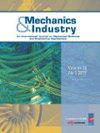Thermo-viscoplastic numerical modeling of metal forging process by Pseudo Inverse Approach
IF 1.2
4区 工程技术
Q3 ENGINEERING, MECHANICAL
引用次数: 0
Abstract
Constant demands of light-weighting have forced many industries to resort to manufacturing practices that promise a component with a higher strength-to-weight ratio. Hot forging is one such method used to produce parts using difficult-to-form materials as well as to achieve complex geometries. Although numerical methods provide an efficient means to predict the material yield and the stress/strain states of the product at different stages of forming and classical methods are accurate enough to provide a suitable representation of the process, they tend to be computationally expensive. This limits their use in process optimization studies. The Pseudo Inverse Approach (PIA) developed in the context of 2D axisymmetric cold forming, provides a quick and fairly accurate estimate of the stress and strain fields in the final product for a given initial shape. In this work, the PIA is extended to include the thermal and viscoplastic effects associated with the hot forging process. The results are compared with commercially available software based on the classical approaches to show the efficiency and the limitations of PIA.金属锻造过程的伪逆热粘塑性数值模拟
对轻量化的持续需求迫使许多行业诉诸于承诺具有更高强度重量比的组件的制造实践。热锻就是这样一种方法,用于使用难以成形的材料生产零件,并实现复杂的几何形状。尽管数值方法提供了一种有效的方法来预测材料产量和产品在不同成形阶段的应力/应变状态,并且经典方法足够精确,可以提供合适的过程表示,但它们往往计算成本很高。这限制了它们在工艺优化研究中的应用。在二维轴对称冷成形的背景下,伪逆方法(PIA)提供了一个快速和相当准确的估计在给定的初始形状的最终产品的应力和应变场。在这项工作中,PIA被扩展到包括与热锻造过程相关的热和粘塑性效应。将结果与基于经典方法的商业软件进行了比较,以显示PIA的效率和局限性。
本文章由计算机程序翻译,如有差异,请以英文原文为准。
求助全文
约1分钟内获得全文
求助全文
来源期刊

Mechanics & Industry
ENGINEERING, MECHANICAL-MECHANICS
CiteScore
2.80
自引率
0.00%
发文量
25
审稿时长
>12 weeks
期刊介绍:
An International Journal on Mechanical Sciences and Engineering Applications
With papers from industry, Research and Development departments and academic institutions, this journal acts as an interface between research and industry, coordinating and disseminating scientific and technical mechanical research in relation to industrial activities.
Targeted readers are technicians, engineers, executives, researchers, and teachers who are working in industrial companies as managers or in Research and Development departments, technical centres, laboratories, universities, technical and engineering schools. The journal is an AFM (Association Française de Mécanique) publication.
 求助内容:
求助内容: 应助结果提醒方式:
应助结果提醒方式:


